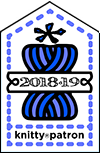Bremen Library Bag, a free knitting pattern from Knitty.com. Free knitting pattern for a DETAILS HERE.
INTRODUCTION
Bremen Library Bag
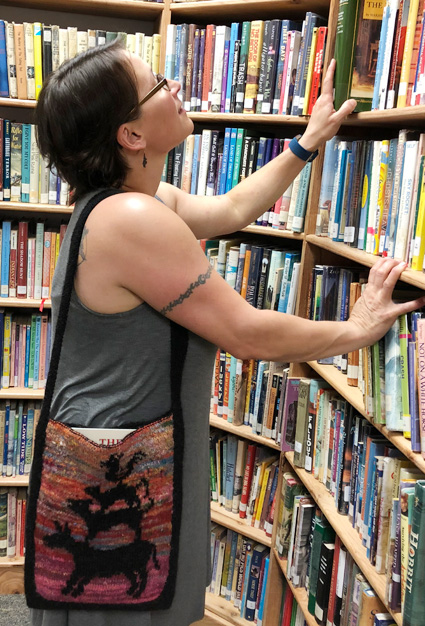 by Stefanie Johnson
by Stefanie Johnson
![]()
The Bremen Town Musicians was one of my favorite fairy tales growing up. It was first published in Grimms' Fairy Tales back in 1819 and tells the story of four aging animals whose owners no longer find them useful. One by one, they decide to run away to the town of Bremen to become musicians. They travel down the country road as the sun is setting, stacked one atop the others. The group never actually arrives in Bremen; they trick a band of robbers and scare them from their home, taking the loot and home for themselves. A bronze statue of the Bremen Town Musicians created by Gerhard Marcks was erected in 1953 in Bremen, Germany.
The design for this bag was inspired by the textures and colors of some fiber given to me as gifts. The black alpaca fiber from my sister Emily was not soft enough for next to skin wear, but seemed durable enough for a bag. The colorful contrast yarn was a crazy batt given to me by Natasha of Esther's Place Fibers when I moved that reminded me of a beautiful sunset as I spun it.
To keep the colors from getting muddied up during plying, I decided to ply the single with a strand of grey wooly nylon for a slightly textured homespun-look. The front panel of the bag is double knit, making the bag reversible and also preventing long floats on the inside of the bag for book corners or fingers to catch on. The remainder of the bag is worked in linen stitch for structure and to reduce stretch.
 model: Stefanie Johnson
model: Stefanie Johnson
 photos: Samantha Johnson
photos: Samantha Johnson
SIZE
One
FINISHED MEASUREMENTS
Width: 9.25 inches/23.5 cm
Height: 12 inches/30.5 cm
Depth: 1.5 inches/4 cm
Strap length: 28 inches/71 cm (customizable)
MATERIALS
Fibre
![]() [MC] 100% alpaca batt; color: black; 7.5 ounces/213g
[MC] 100% alpaca batt; color: black; 7.5 ounces/213g
![]() [CC] Esther's Place Fibers [merino wool, bamboo, silk threads, Angelina, pluckyfluff; crazy batt]; color: one-of-a-kind; 1 ounce/28g
[CC] Esther's Place Fibers [merino wool, bamboo, silk threads, Angelina, pluckyfluff; crazy batt]; color: one-of-a-kind; 1 ounce/28g
Finished Yarn
![]() Wraps per inch: 12
Wraps per inch: 12
![]() Ply: 2
Ply: 2
![]() Yardage used: [MC] 284yd/260m; [CC] 96yd/88m
Yardage used: [MC] 284yd/260m; [CC] 96yd/88m
![]() Drafting methods:
Drafting methods:
[MC] Fiber pre-drafted and spun worsted using short forward draw method
[CC] Fiber pre-drafted and spun semi-woolen using the American sliding supported long draw method
All singles were spun “Z” and plied “S”; CC singles were plied with commercially available ThreadArt wooly nylon thread in grey (color 9116).
Commercial Yarn Alternative
![]() [MC] Cascade 220 Sport Yarn [100% peruvian highland wool; 164yd/150m per 50g skein]; color: Jet (4002); 3 skeins
[MC] Cascade 220 Sport Yarn [100% peruvian highland wool; 164yd/150m per 50g skein]; color: Jet (4002); 3 skeins
![]() [CC] Freia Fine Handpaints Ombre Sport Yarn [100% wool; 217yd/198m per 75g skein]; color: Metropolis; 1 skein
[CC] Freia Fine Handpaints Ombre Sport Yarn [100% wool; 217yd/198m per 75g skein]; color: Metropolis; 1 skein
Recommended needle size
[always use a needle size that gives you the gauge listed below - every knitter's gauge is unique]
![]() 1 set US #3/3.25mm needles for working flat
1 set US #3/3.25mm needles for working flat
![]() 2 US #3/3.25mm circular needles, 24 inch/60 cm long
2 US #3/3.25mm circular needles, 24 inch/60 cm long
![]() 1 set US #7/4.5mm needles for working flat
1 set US #7/4.5mm needles for working flat
![]() 1 set US #7/4.5mm double-point needles
1 set US #7/4.5mm double-point needles
Notions
![]() yarn needle
yarn needle
![]() blocking board and pins
blocking board and pins
GAUGE
24 stitches/31 rows = 4 inches/10cm in double knit stockinette stitch, blocked
26 stitches/40 rows = 4 inches/10cm in linen stitch, blocked
PATTERN NOTES
[Knitty's list of standard abbreviations and techniques can be found here.]
The front of the bag is worked in double knitting. The back, sides, bottom and strap of the bag are worked in linen stitch. The front and back panels are connected at the same time the strap (which forms the sides and backs) is worked.
Double knitting: each stitch on the chart represent two stitches, a knit stitch on the side facing you and a purl stitch on the side facing away from you. On odd rows, if the stitch is marked as MC, k1 MC, p1 CC. If the stitch is marked as CC, k1 CC, p1 MC.
When working even rows, your MC and CC are reversed. This results in a reversible fabric where the colors are reversed on the back side. It is essentially knitting two pieces at the same time that are connected in between the fabric layers when the yarn colors switch. For this reason, it is important to twist the yarns at the start of each row or the edges will not be connected; they will gap open. It may help to think of the two colors as background color and pattern color so when you are on the WS of the chart it is easier to remember which color to start with- just look to your knitted piece for direction. CreaCrafts has a basic video on double knitting that may be helpful, but please note that she uses a different cast on technique than in this pattern.
Linen stitch (over even number of stitches)
Row 1 [RS]: *K1, slip 1 pwise wyif; repeat from * to end of row.
Row 2 [WS]: *P1, slip 1 pwise wyib; repeat from * to end of row.
Repeat Rows 1-2 for pattern.
CHARTS
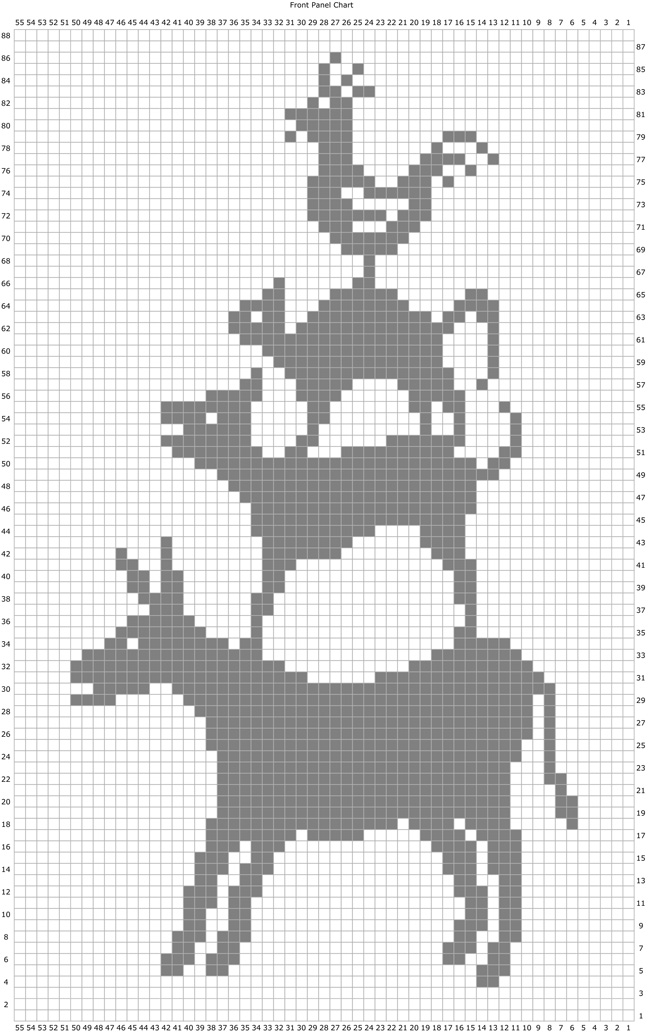
DIRECTIONS

Front Panel
With larger needles for working flat and the long tail cast on method, cast on 55 sts with MC.
Switch to smaller needles for working flat.
Set up row [RS]: *Knit into the front of stitch with CC, knit into the back of the stitch with MC; repeat from * to end of row. 110 sts. This cast on and set-up row will result in a firmer edge to the panel so it will not stretch out of shape as much as an invisible two color cast on.
Next row [WS]: *K1 MC, p1 CC; repeat from * to end of row.
Next row [RS]: Begin to work Rows 1-89 of Bremen Bag chart.
Bind off on WS as follows: K1, *k2tog, pass 1st st on right needle over 2nd st on right needle; repeat from * to end of row.
Cut yarn, leaving a 6 inch/15 cm tail and fasten off last st. Block to measurements.
Back Panel
With larger needles for working flat and the long-tail cast on method, cast on 60 sts with MC. Work in linen stitch until panel measures approximately 12 inches/30.5 cm, or the same length as the Front Panel.
Bind off in linen stitch on the next RS row, leaving the last stitch on the needle.
Strap
With smaller circular needle, pick up the 60 purl bumps along the long side of the back panel adjacent to the one remaining live st. With the second smaller circular needle, pick up 60 sts (approximately 2 sts for every 3 rows) along the right side of the front panel.
Note: If your gauge differs from pattern gauge, use your linen st gauge to determine how many sts to pick up per inch along the sides of the panel and use that number accordingly.
Transfer the single live st from the corner of the back panel to a larger double-point needle, and using the cabled cast on, cast on 11 additional sts. 12 sts. Do not turn work. Move 1st stitch from front panel to the double-point needle.
Beginning with a RS row, work in linen stitch, attaching the panels as you knit by working the first stitch of each row together with a stitch from one of the panels. On RS rows, this will be accomplished by k2tog, on WS rows, p2tog.
When you reach the bottom corner of the panels, pick up 55 sts along the bottom of each panel and continue to work in linen stitch, attaching the panels as established.
When you reach the next corner, pick up 60 purl bumps from the other side of the back panel and pick up 60 sts (approximately 2 sts for every 3 rows) along the other side of the front panel, and continue to work in linen stitch, attaching the panels as established.
Once all three sides are attached, continue to work in linen stitch for 28 inches/71cm, or desired length.
Pick up 12 sts from the cast-on edge of strap and attach the ends using a three-needle bind off on the inside.
Cut yarn leaving a 6 inch/15 cm tail.
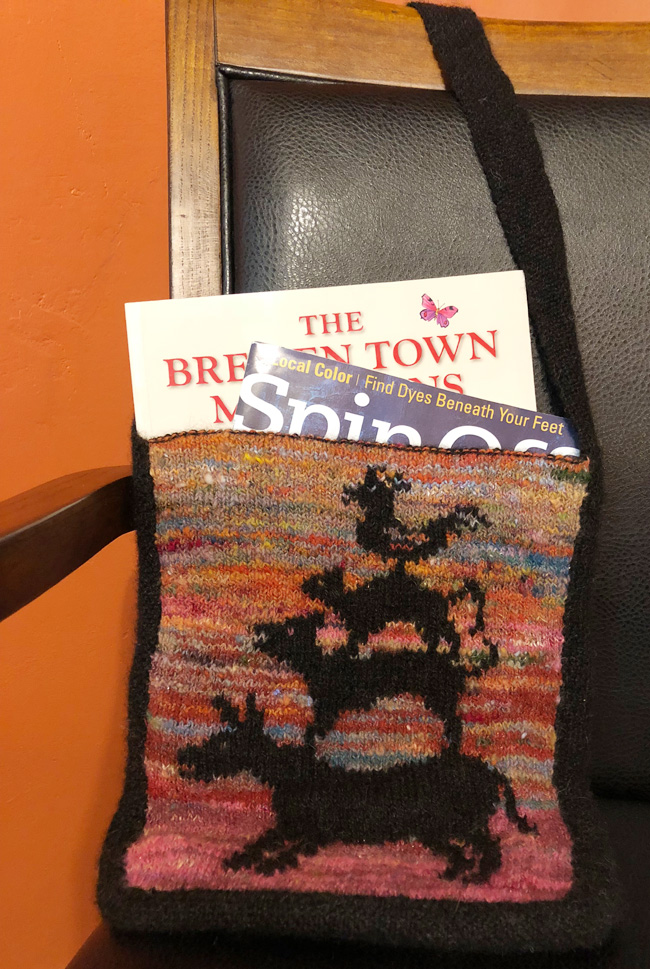
FINISHING
Weave in all ends. Block to size and shape. Consider using an appropriately sized box or Tupperware container to help hold the shape during blocking.
ABOUT THE DESIGNER
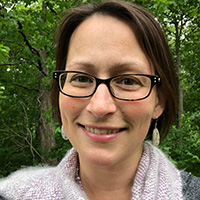 Stefanie has had a love for textiles and fiber arts since childhood. When she is not protecting the public as a health inspector, Stefanie enjoys creating unique items and helping others learn to spin, knit and weave. Along with her husband, Jason, and children Samantha and Lincoln, she raises French Angora rabbits, honey bees and a variety of chickens and ducks on their hobby farm Settlers Grove in Illinois.
Stefanie has had a love for textiles and fiber arts since childhood. When she is not protecting the public as a health inspector, Stefanie enjoys creating unique items and helping others learn to spin, knit and weave. Along with her husband, Jason, and children Samantha and Lincoln, she raises French Angora rabbits, honey bees and a variety of chickens and ducks on their hobby farm Settlers Grove in Illinois.
More of Stefanie's work can be found in Spin Off magazine and on Ravelry.
Pattern & images © 2019 Stefanie Johnson.




